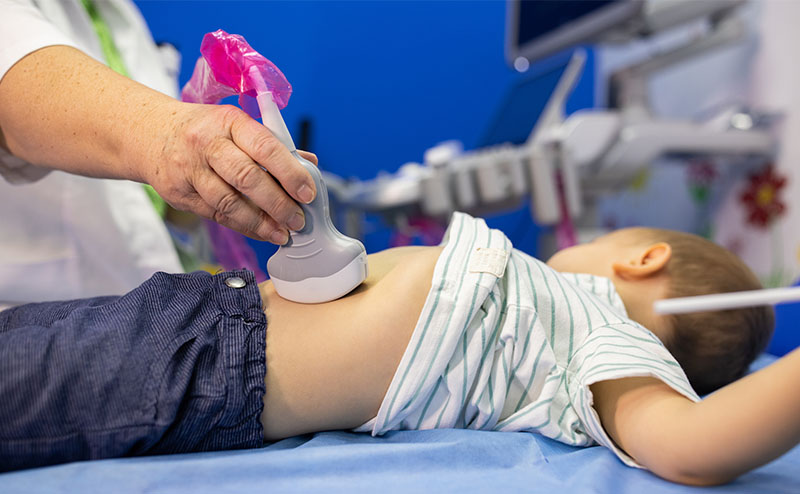
HOCUS POCUS – Tips for Calming and Charming Pediatric Patients receiving Point-of-care Ultrasound
Kathleen Felisca, MD
Pediatric Emergency Medicine Fellow: Connecticut Children's, Hartford CT/University of Connecticut School of Medicine
Special Acknowledgements:
Jonathan J. Neville, BSc (Hons), MBBS, MRCS
Jamie Clukey, RT, RBMS
Bridget Butler, RT
Point-of-care ultrasound (POCUS) can be used to quickly diagnose acute illnesses and expedite appropriate medical management in children. For example, using POCUS to find free fluid and an enlarged, hyperemic, thick-walled appendix in a young child for whom you are highly suspicious for appendicitis may save valuable time if department ultrasound technicians are busy imaging other patients.
However, scanning a screaming child in the emergency department is often a difficult feat. Between the cramped room, anxious parents, a child writhing in pain, and a bustling emergency department full of patients waiting to be seen, obtaining appropriate views quickly and efficiently may feel like mission impossible. An emergency visit is full of frightening unknowns for an ill child and approaching someone with a large machine attached to a large gray stick would be intimidating for any individual.
Three excellent, experienced radiology technicians in our pediatric Emergency Department were interviewed and “probed” on tips to support pediatric patients through ultrasound scans. With a total of 36 years (9, 11, and 16) of pediatric ultrasound experience between them, they had a lot to share. Below is a summary of the conversations.
Pediatric vs Adult Ultrasound
From a technical perspective children often have clearer windows compared to adults. Their bodies are also smaller which allows for easier ergonomics. However, children are less cooperative; even if they start off calm - it may not be for long. It is important to work quickly, whereas an adult in pain may be able to purposefully sit still for an exam, a child may not be as patient.
Communication
“This is a camera that we will use to look inside your belly. It doesn’t hurt, the camera is smooth, and the jelly is soft.”
Explain the process of the procedure. Show the patient the probe and ultrasound gel, place it on a finger or leg. Allow the child to be comfortable with the equipment, have them hold the probe or the gel bottle. Call the gel ‘slime’ if you think they’d get a kick out of it. Blue-colored ultrasound gel may make the process more entertaining for the patient. If the patient has a stuffed animal, ask if they’d like it to be scanned first. Prior to scanning, point and touch the areas of interest to have the child know what to expect.
Comforting Children
Answer questions the patient may have. Gauge the developmental level and personality of the child to determine whether to answer questions in greater detail or in simpler terms.
The application of cold or room temperature gel may be startling or uncomfortable. Use gel warmers if possible. If your department doesn’t have designated gel warmers, alternatives include laying pouches of gel on the warm ultrasound machine or keeping them in your breast pocket.
Keeping the room dark, quiet, and with minimal personnel can keep the energy in the room controlled and the patient relaxed. For some, playing music may ease anxiety as well.
Handling Restless/ Frightened Children
When their child is frightened, a parent’s reflex is to pick them up, to hug or comfort them to give them a boost of courage. However, this does not typically work. The child may be calm for a second, but once they’re placed back down, they will likely be just as anxious. Leave the child on the stretcher and have the parent sit with them and rub their head or an extremity instead. Allow them to offer comfort in other ways.
Children are sometimes distractible and asking them about themselves or their interests may take their focus off their exam. “What do you like to do for fun? What do you like to do in school? Do you have any pets? Do you have any sisters or brothers?”
Some children do not do well with conversations or technical explanations, either due to developmental stage or anxiety. In these cases, distraction tools may be more helpful. Utilizing Child Life resources, light up toys, a tablet with games, or just playing the famous Ms. Rachel may help to get the job done.
If none of these tactics work, simply try to work as quickly as possible to obtain the images needed.
Handling Children in Pain
“I’m sorry, I know this is painful but when you tense up your belly muscles it makes it harder to see the pictures. If you take big breaths and keep your belly soft, I won’t have to push as hard.”
Looking for appendicitis or intussusception involves graded compression in a child who is already endorsing abdominal discomfort. If possible, have the child take slow breaths and encourage them to keep their abdomen soft and relaxed. Let them know the longer they stay still, the quicker they’ll be done. Having pain meds on board (ex. acetaminophen, ibuprofen) prior to scanning is an important tip as well!
Challenging Parents/ Families
At times parents are much more difficult to calm. They may actively or unconsciously transfer their anxiety onto their child. State you are trying to move as quickly as possible. Try to sympathize with the family. “I understand they’re uncomfortable, I’m sorry. We’re just trying to get the best images we can to help diagnose them. We’re getting good information.”
Additional Pearls
Pylorus: A view of the pylorus can be difficult to obtain due to the size of the pylorus or gaseous distension. Try to turn the patient onto their left side to try to move the air out of the way. You can also try to use the liver as an acoustic window. Put the probe over the liver and aim towards the left inguinal area.
If your machine appears to provide suboptimal image quality for your pediatric patients, consider having an experienced sonographer visit the emergency department to help optimize machine settings and set customized presets for different exams.
Conclusion
Utilizing POCUS in the emergency department may be a stressful process for patients and guardians/parents. However, timely scans may expedite your clinical decision making. While working with tearful patients or anxious parents, remember you are seeing a family through a new and stressful experience. Remember to act with patience and understanding while communicating with and scanning children. Comforting a child by preparing them for what’s to come, setting the right environment, treating their pain with analgesics, communicating through the procedure, and the use of distraction tools can allow you to obtain the images needed while minimizing physical and emotional stress.



